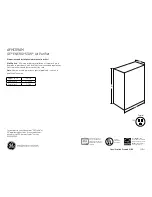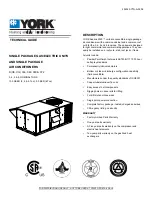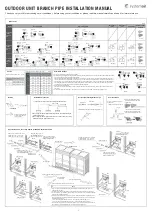
5292157-UIM-B-0317
Johnson Controls Unitary Products
15
SECTION XII: AIRFLOW AND COMFORT
SETTING SELECTION
AIRFLOW SELECTION AT THERMOSTAT
Inputs to air handler control board come from the thermostat which are
communicated from the main control of the outdoor unit. This maintains
proper sensible/latent balance during cooling and proper discharge
temperature during heating.
Proper indoor unit airflow is determined by the system and requires no
initial set-up by the installing contractor. If the indoor unit is using
electric heat, the unit must have the electric heat airflow set at the air
handler control board HEAT jumper. Refer to electric heat minimum fan
speed and the air flow data tables for proper selection when operating
the air handler with the electric heat section.
After the system is started during the initial set-up process using the
Hx
TM
thermostat, additional fine tuning of the airflow is accomplished by
selecting one of the climate setting profiles. The comfort profiles
include: humid, dry or normal. Select the one that best reflects the
outdoor environment where the conditioned space is located. This
selection adjusts how the indoor blower and the compressor work
together to manage temperature and humidity.
The normal comfort setting operates the indoor blower speed as
commanded by the outdoor unit
.
The humid comfort setting either
decreases the commanded indoor blower speed or increases the
compressor speed depending on the demand to best manage humidity.
The dry comfort setting increases the commanded indoor blower speed
in relation to the compressor speed to optimize sensible cooling.
Additional airflow fine tune adjustments are available using the
Hx
thermostat. Refer to the
Hx
thermostat manual for additional detail and
the selectable “Blower Operating Profiles” available.
These variable speed air handlers are designed to deliver constant air-
flow (CFM) up to a maximum of 0.8 inches external static pressure
(ESP) in the ductwork. Therefore, if too many supply registers are
closed, a filter becomes clogged, or there is a restriction in the
ductwork, the motor automatically operates at a higher speed to com-
pensate for the higher ESP. This may result in a higher operating sound
level, a higher power consumption, and have a negative impact on the
service life of the blower motor.
To Set Cooling Airflow:
The modulating outdoor AC or HP operate the indoor blower in conjunc-
tion with the outdoor unit compressor speed.
To Set Heat Pump Airflow:
The modulating outdoor AC or HP operate the indoor blower in conjunc-
tion with the outdoor unit compressor speed.
To Set Electric Heat Airflow:
The blower speed required for electric heat is different than cooling.
Refer to Table 14 for the possible CFM selections. Refer to Table 7 for
the minimum required airflow for the electric heater installed. Find the
desired airflow in Table 14 for heat. Set the HEAT jumper on the control
as indicated in Table 14.
Blower Ramp-Up /Ramp-Down:
To minimize the sound made by the blower when it speeds up or slows
down, the blower will slowly ramp up or down from one speed to
another. Changes in blower speed during A/C or heat pump heating can
take up to 30 seconds. Changes in blower speed during electric resis-
tance heating can take up to 15 seconds.
BLOWER OPERATING PROFILES
The blower operating profiles are to be selected on the Hx
TM
communicating thermostat. This controls blower operation at the
beginning and the end of a demand.
Normal
The normal setting provides a ramp-up from zero airflow to full capacity
and a ramp-down from full capacity back to zero airflow.
Humid
The humid setting is best-suited for installations where the humidity is
frequently very high during cooling season, such as in the southern part
of the country. On a call for cooling, the blower will ramp up to 50% of
full capacity and will stay there for two minutes, then will ramp up to
82% of full capacity and will stay there for five minutes, and then will
ramp up to full capacity, where it will stay until the wall thermostat is sat-
isfied.
Dry
The dry setting is best suited to parts of the country where excessive
humidity is not generally a problem, where the summer months are usu-
ally dry. On a call for cooling the motor will ramp up to full capacity and
will stay there until the thermostat is satisfied. At the end of the cooling
cycle, the blower will ramp down to 50% of full capacity where it will stay
for 60 seconds. Then it will ramp down to zero.
Temperate
The temperate setting is best suited for most of the country, where nei-
ther excessive humidity nor extremely dry conditions are the norm. On
a call for cooling, the motor will ramp up to 63% of full capacity and will
stay there for 90 seconds, then will ramp up to full capacity. At the end
of the cooling cycle, the motor will ramp down to 63% of full capacity
and will stay there for 30 seconds, then will ramp down to zero.
NOTICE
Incorrect airflow and comfort settings may result in decreased system
efficiency and performance.
















































